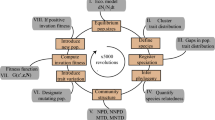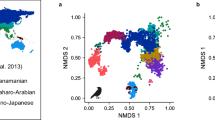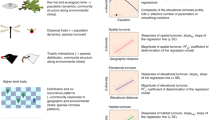Abstract
Ecological communities are assembled from the overlapping of species in geographic space, but the mechanisms facilitating or limiting such overlaps are difficult to resolve. Here, we combine phylogenetic, morphological and environmental data to model how multiple processes regulate the origin and maintenance of geographic range overlap across 1,115 pairs of avian sister species globally. We show that coexistence cannot be adequately predicted by either dispersal-assembly (that is, biogeographic) models or niche-assembly models alone. Instead, our results overwhelmingly support an integrated model with different assembly processes dominating at different stages of coexistence. The initial attainment of narrow geographic overlap is dictated by intrinsic dispersal ability and the time available for dispersal, whereas wider coexistence is largely dependent on niche availability, increasing with ecosystem productivity and divergence in niche-related traits, and apparently declining as communities become saturated with species. Furthermore, although coexistence of any individual pair of species is highly stochastic, we find that integrating assembly processes allows broad variation in the incidence and extent of coexistence to be predicted with reasonable accuracy. Our findings demonstrate how phylogenetic data coupled with environmental factors and functional traits can begin to clarify the multi-layered processes shaping the distribution of biodiversity at large spatial scales.
This is a preview of subscription content, access via your institution
Access options
Access Nature and 54 other Nature Portfolio journals
Get Nature+, our best-value online-access subscription
$29.99 / 30 days
cancel any time
Subscribe to this journal
Receive 12 digital issues and online access to articles
$119.00 per year
only $9.92 per issue
Buy this article
- Purchase on Springer Link
- Instant access to full article PDF
Prices may be subject to local taxes which are calculated during checkout




Similar content being viewed by others
Change history
18 June 2019
The Supplementary Data file initially published online was corrupted and was replaced on 18th June 2019.
References
Ricklefs, R. E. Disintegration of the ecological community. Am. Nat. 172, 741–750 (2008).
Hubbell, S. P. The Unified Neutral Theory of Biodiversity and Biogeography (Princeton Univ. Press, Princeton, 2001).
Wiens, J. J. The niche, biogeography and species interactions. Phil. Trans. R. Soc. B 366, 2336–2350 (2011).
MacArthur, J. W. & Wilson, E. O. The Theory of Island Biogeography (Princeton Univ. Press, Princeton, 1967).
Harmon, L. J. & Harrison, S. Species diversity is dynamic and unbounded at local and continental scales. Am. Nat. 185, 584–593 (2015).
Leprieur, F. et al. Plate tectonics drive tropical reef biodiversity dynamics. Nat. Commun. 7, 11461 (2016).
MacArthur, R. H. Geographical Ecology: Patterns in the Distributions of Species (Harper and Row, New York, 1972).
Diamond, J. M. in Ecology and Evolution of Communities (eds Cody, M. L. & Diamond, J. M.) 342–444 (Harvard Univ. Press, Cambridge, 1975).
Chase, J. M. & Leibold, M. A. Ecological Niches: Linking Classical and Contemporary Approaches (Univ. Chicago Press, Chicago, 2003).
Levine, J. M. & HilleRisLambers, J. The importance of niches for the maintenance of species diversity. Nature 461, 254–257 (2009).
Price, T. D. et al. Niche filling slows the diversification of Himalayan songbirds. Nature 509, 222–225 (2014).
Rabosky, D. L. & Hurlbert, A. Species richness at continental scales is dominated by ecological limits. Am. Nat. 185, 572–583 (2015).
Pigot, A. L., Tobias, J. A. & Jetz, W. Energetic constraints on species coexistence in birds. PLoS Biol. 14, e1002407 (2016).
Vellend, M. The Theory of Ecological Communities (Princeton Univ. Press, Princeton, 2016).
Gravel, D., Canham, C. D., Beaudet, M. & Messier, C. Reconciling niche and neutrality: the continuum hypothesis. Ecol. Lett. 9, 399–409 (2006).
Leibold, M. A. et al. The metacommunity concept: a framework for multi-scale community ecology. Ecol. Lett. 7, 601–613 (2004).
Tilman, D. Niche tradeoffs, neutrality, and community structure: a stochastic theory of resource competition, invasion, and community assembly. Proc. Natl Acad. Sci. USA 101, 10854–10861 (2004).
Pigot, A. L. & Etienne, R. S. A new dynamic null model for phylogenetic community structure. Ecol. Lett. 18, 153–163 (2015).
Mittelbach, G. & Schemske, D. W. Ecological and evolutionary perspectives on community assembly. Trends Ecol. Evol. 30, 241–247 (2015).
Boulangeat, I., Gravel, D. & Thuiller, W. Accounting for dispersal and biotic interactions to disentangle the drivers of species distributions and their abundances. Ecol. Lett. 15, 584–593 (2012).
Tilman, D. Community invasibility, recruitment limitation, and grassland biodiversity. Ecology 78, 81–92 (1997).
Gilbert, B. & Lechowicz, M. J. Neutrality, niches, and dispersal in a temperate forest understory. Proc. Natl Acad. Sci. USA 101, 7651–7656 (2004).
Warren, D. L., Cardillo, M., Rosauer, D. F. & Bolnick, D. I. Mistaking geography for biology: inferring processes from species distributions. Trends Ecol. Evol. 29, 572–580 (2014).
McGill, B. J. Matters of scale. Science 328, 575–576 (2010).
Chase, J. M. Spatial scale resolves the niche versus neutral theory debate. J. Veg. Sci. 25, 319–322 (2014).
Pigot, A. L. & Tobias, J. A. Species interactions constrain geographic range expansion over evolutionary time. Ecol. Lett. 16, 330–338 (2013).
Weber, M. G., Wagner, C. E., Best, R. J., Harmon, L. J. & Matthews, B. Evolution in a community context: on integrating ecological interactions and macroevolution. Trends Ecol. Evol. 32, 291–304 (2017).
Pigot, A. L. & Tobias, J. A. Dispersal and the transition to sympatry in vertebrates. Proc. R. Soc. B 282, 20141929 (2015).
Weber, M. G. & Strauss, S. Y. Coexistence in close relatives: beyond competition and reproductive isolation in sister taxa. Annu. Rev. Ecol. Evol. Syst. 47, 359–381 (2016).
Lowe, W. H. & McPeek, M. A. Is dispersal neutral? Trends Ecol. Evol. 29, 444–450 (2014).
Mayr, E. Bird speciation in the tropics. J. Ecol. 57, 1–17 (1969).
Davies, T. J., Meiri, S., Barraclough, T. G. & Gittleman, J. L. Species co-existence and character divergence across carnivores. Ecol. Lett. 10, 146–152 (2007).
Anacker, B. L. & Strauss, S. Y.The geography and ecology of plant speciation: range overlap and niche divergence in sister species. Proc. R. Soc. B 281, 20132980 (2014).
Jetz, W., Thomas, G. H., Joy, J. B., Hartmann, K. & Mooers, A. O. The global diversity of birds in space and time. Nature 491, 444–448 (2012).
Claramunt, S., Derryberry, E. P., Remsen, J. V. & Brumfield, R. T. High dispersal ability inhibits speciation in a continental radiation of passerine birds. Proc. R. Soc. B 279, 1567–1574 (2012).
Pigot, A. L., Trisos, C. & Tobias, J. A.Functional traits reveal the expansion and packing of ecological niche space underlying an elevational diversity gradient in passerine birds. Proc. R. Soc. B 283, 20152013 (2016).
Grant, P. R. & Grant, B. R. Evolution of character displacement in Darwin’s finches. Science 313, 224–226 (2006).
Losos, J. B. & Glor, R. E. Phylogenetic comparative methods and the geography of speciation. Trends Ecol. Evol. 18, 220–227 (2003).
Fitzpatrick, B. M. & Turelli, M. The geography of mammalian speciation: mixed signals from phylogenies and range maps. Evolution 60, 601–615 (2006).
Weir, J. T. & Price, T. D. Limits to speciation inferred from times to secondary sympatry and ages of hybridizing species along a latitudinal gradient. Am. Nat. 177, 462–469 (2011).
Kennedy, J. D. et al. The influence of wing morphology upon the dispersal, geographical distributions and diversification of the Corvides (Aves; Passeriformes). Proc. R. Soc. B 283, 20161922 (2016).
Ricklefs, R. E. Host–pathogen coevolution, secondary sympatry and species diversification. Phil. Trans. R. Soc. B 365, 1139–1147 (2010).
Cooney, C. R., Tobias, J. A., Weir, J. T., Botero, C. A. & Seddon, N. Sexual selection, speciation, and constraints on geographical range overlap in birds. Ecol. Lett. 20, 863–871 (2017).
Mayfield, M. M. & Levine, J. M. Opposing effects of competitive exclusion on the phylogenetic structure of communities. Ecol. Lett. 13, 1085–1093 (2010).
Chesson, P. Mechanisms of maintenance of species diversity. Annu. Rev. Ecol. Syst. 31, 343–366 (2000).
Kraft, N. J. B., Godoy, O. & Levine, J. M. Plant functional traits and the multidimensional nature of species coexistence. Proc. Natl Acad. Sci. USA 112, 797–802 (2015).
Brown, W. L. & Wilson, E. O. Character displacement. Syst. Zool. 5, 49–64 (1956).
Hutchinson, G. E. Homage to Santa Rosalia or why are there so many kinds of animals? Am. Nat. 93, 145–159 (1959).
Currie, D. J. et al. Predictions and tests of climate-based hypotheses of broad-scale variation in taxonomic richness. Ecol. Lett. 7, 1121–1134 (2004).
Pfennig, D. W. & Pfennig, K. S. Character displacement and the origins of diversity. Am. Nat. 176, S26–S44 (2010).
Macarthur, R. & Macarthur, J. W. On bird species diversity. Ecology 42, 594–598 (1961).
Hurlbert, A. H. & Jetz, W. More than “more individuals”: the nonequivalence of area and energy in the scaling of species richness. Am. Nat. 176, E50–E65 (2010).
Rosenzweig, M. L. in The Ecology and Evolution of Communities (eds Cody, M. & Diamond, J. M.) 121–140 (Harvard Univ. Press, Cambridge, 1975).
Rabosky, D. L. & Glor, R. E. Equilibrium speciation dynamics in a model adaptive radiation of island lizards. Proc. Natl Acad. Sci. USA 107, 22178–22183 (2010).
Cornell, H. V. Is regional species diversity bounded or unbounded?. Biol. Rev. 88, 140–165 (2013).
Jetz, W. & Fine, P. V. A.Global gradients in vertebrate diversity predicted by historical area-productivity dynamics and contemporary environment.PLoS Biol. 10, e1001292 (2012).
Garzon-Lopez, C. X., Jansen, P. A., Bohlman, S. A., Ordonez, A. & Olff, H. Effects of sampling scale on patterns of habitat association in tropical trees. J. Veg. Sci. 25, 349–362 (2014).
Lawton, J. H. Are there general laws in ecology? Oikos 84, 177–192 (1999).
Hackett, S. J. et al. A phylogenomic study of birds reveals their evolutionary history. Science 320, 1763–1768 (2008).
Weir, J. T. & Schluter, D. Calibrating the avian molecular clock. Mol. Ecol. 17, 2321–2328 (2008).
Jetz, W., Wilcove, D. S. & Dobson, A. P. Projected impacts of climate and land-use change on the global diversity of birds. PLoS Biol. 5, 1211–1219 (2007).
Cramer, W. et al. Comparing global models of terrestrial net primary productivity (NPP): overview and key results. Glob. Change Biol. 5, 1–15 (1999).
Wilman, W., Belmaker, J., Simpson, J., de la Rosa, C. & Rivadeneira, M. M. EltonTraits 1.0: species-level foraging attributes of the world’s birds and mammals. Ecology 95, 2027 (2014).
Miles, D. B. & Ricklefs, R. E. The correlation between ecology and morphology in deciduous forest passerine birds. Ecology 65, 1629–1640 (1984).
Grant, P. R. The Ecology and Evolution of Darwin’s Finches (Princeton Univ. Press, Princeton, 1999).
Schoener, T. W. Large-billed insectivorous birds: a precipitous diversity gradient. Condor 73, 154–161 (1971).
Mayr, E. Systematics and the Origin of Species (Columbia Univ. Press, New York, 1942).
Coyne, J. A. & Price, T. D. Little evidence for sympatric speciation in island birds. Evolution 54, 2166–2171 (2000).
Phillimore, A. B. et al. Sympatric speciation in birds is rare: insights from range data and simulations. Am. Nat. 171, 646–657 (2008).
R Development Core Team R: A Language and Environment for Statistical Computing (R Foundation for Statistical Computing, Vienna, 2015).
Jackson, C. H. Multi-state models for panel data: the msm package for R. J. Stat. Softw. 38, 1–28 (2011).
Burnham, K. P. & Anderson, D. R. Multimodel inference. Sociol. Methods Res. 33, 261–304 (2004).
Hadfield, J. D. & Nakagawa, S. General quantitative genetic methods for comparative biology: phylogenies, taxonomies and multi-trait models for continuous and categorical characters. J. Evol. Biol. 23, 494–508 (2010).
McFadden, D. in Frontiers in Econometrics (ed. Zarembka, P.) 104–142 (Academic Press, New York, 1974).
Acknowledgements
We are grateful to C. Cooney, C. Trisos and members of the Jetz Lab for feedback, helpful discussions and comments that greatly improved the manuscript. This research was funded by the Netherlands Organisation for Scientific Research VENI grant 863.13.003 (to A.L.P.), NASA Biodiversity grant NNX11AP72G and NSF grants NSF DBI 1262600, DBI 0960550 and DEB 1026764 (to W.J.), the Oxford Clarendon Fund and US-UK Fulbright Commission (to C.S.), and the John Fell Fund and NERC grant NE/I028068/1 (to J.A.T.). We thank many museums for access to specimens, and in particular the Natural History Museum at Tring (see Supplementary information for an expanded list of contributing individuals and institutions).
Author information
Authors and Affiliations
Contributions
A.L.P., W.J., C.S. and J.A.T. conceived the study. C.S., J.A.T. and W.J. contributed data. A.L.P. performed the analysis and wrote the first draft. All authors contributed to the writing of the manuscript.
Corresponding author
Ethics declarations
Competing interests
The authors declare no competing interests.
Additional information
Publisher’s note: Springer Nature remains neutral with regard to jurisdictional claims in published maps and institutional affiliations.
Supplementary information
Supplementary Information
Supplementary Figures 1–9, Supplementary Tables 1–5
Supplementary Data
A .zip file containing the code and data used in the analysis
Supplementary Note
A description of the contents of Supplementary Data .zip file, which contains three folders: ‘Code’,‘InputData’ and ‘Output’
Rights and permissions
About this article
Cite this article
Pigot, A.L., Jetz, W., Sheard, C. et al. The macroecological dynamics of species coexistence in birds. Nat Ecol Evol 2, 1112–1119 (2018). https://doi.org/10.1038/s41559-018-0572-9
Received:
Accepted:
Published:
Issue Date:
DOI: https://doi.org/10.1038/s41559-018-0572-9
This article is cited by
-
Climate-driven variation in dispersal ability predicts responses to forest fragmentation in birds
Nature Ecology & Evolution (2023)
-
Land-use diversity predicts regional bird taxonomic and functional richness worldwide
Nature Communications (2023)
-
Ecological drivers of global gradients in avian dispersal inferred from wing morphology
Nature Communications (2020)



